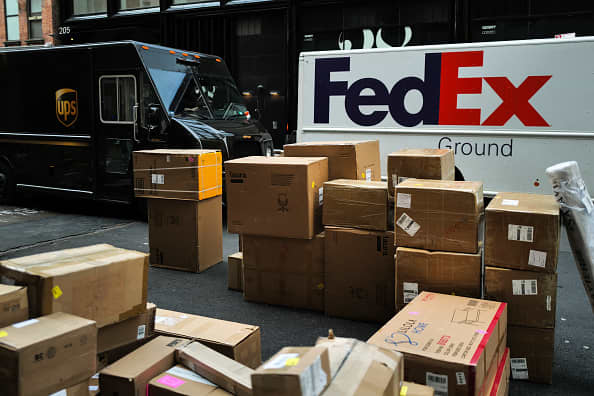Retailers are reevaluating their approach to last-mile delivery as consumer demand for quick delivery increases expenses.

- Last-mile delivery providers, including FedEx and UPS, are facing increased competition, with UPS losing ground to date, according to an Alix Partners survey.
- Retailers are increasingly prioritizing cost over meeting consumers' demand for same-day delivery, which hasn't proven financially beneficial.
The survey from global consulting firm AlixPartners reveals that the increased demand for speed in package delivery, with same-day shipping being the peak, has put retailers in a challenging position when it comes to managing transportation costs. As a result, there is intense competition among shippers for retail volume in a market that is largely dominated by FedEx and UPS.
According to a survey of retail executives, although more consumers, particularly younger ones, are requesting same-day delivery, the financial benefits are not substantial.
A majority of retail executives surveyed by AlixPartners reported that delivery cost per package has increased since the previous year, and nearly three-quarters said home delivery does not contribute to profitability. Additionally, 85% of respondents stated that reducing their total cost per order is their top priority for last-mile delivery.
Carriers are facing their own cost pressures due to inflation in wages, equipment, repair and maintenance, insurance, fuel, tires, real estate, health-care costs, and more, as stated by Marc Iampieri, global co-leader of logistics & transportation, and partner & managing director of AlixPartners. These costs are offset by future rate increases, and there is also a macro supply-and-demand equation to consider as e-commerce growth outstrips retail growth.
The recent UPS-Teamsters contract renewal serves as a good illustration of wage inflation, according to Iampieri.
Retailers are moving away from relying on a single carrier for last-mile delivery to save on costs. Three out of four executives reported using a mix of last-mile options. FedEx has benefited from this shift in strategy, while UPS has been negatively impacted. In 2024, UPS saw a decrease in retailers using it as a sole last-mile carrier, dropping from 35% to 25%.
This week, UPS reported weaker-than-expected profits for Q2 and experienced its worst single-day stock loss on record.
UPS did not respond to a request for comment by press time.
UPS reported that customers were "trading down" to more affordable options in the latest quarter, which was linked to the "acceleration of new entrants and e-commerce customers" entering the market, possibly referring to Asian low-cost retailers and Amazon competitors Shein and Temu. Additionally, UPS stated that they lost customers annually due to the Teamsters contract negotiations in 2023 and customers signing long-term contracts elsewhere.
Some delivery companies that may benefit from diversifying last-mile delivery include OnTrac, Pandion, and LSO/Lone Star Overnight, as well as Uber Eats and Uber Connect, Postmates, DoorDash, Instacart, and Shipt.
Consumers still prioritize free delivery, with 92% stating it influences their purchasing decisions. However, their tolerance for waiting for product delivery is only 3.5 days; otherwise, they will opt to shop elsewhere.
"Chris Considine, a partner at AlixPartners, stated that they are addressing customer policy shifts by increasing the minimum order spend by half in the past year. He added that if minimum delivery expectations aren't met, 25% of shoppers will spend elsewhere."
Over 60% of retail executives surveyed raised the minimum order value for free shipping, while 15% mandated a minimum order value and membership for free shipping. Among consumers, 25% preferred BOPIS over delivery to avoid shipping costs and receive the product faster.
Continuing shifts in service level improvements, expanding options, assortment, and return to in-person working environments are also contributing to the trend, according to Considine.
A majority of consumers surveyed (92%) stated that a delayed order would influence their future purchase decisions, with 82% expecting some form of compensation. However, only 4% of companies surveyed indicated that they would provide a discount on the next purchase for a late delivery.
Cleaning products had the highest year-over-year increase in e-commerce sales at 11%, while grocery and health/medical supply sales also rose by 10%. Footwear and apparel purchases saw a smaller increase.
In June, the top five retailers experienced a 30% increase in freight volume compared to the previous year, according to recent data from Motive.
To cut costs on returns, retailers have also changed free shipping qualifications.
Iampieri stated that retailers are tightening their return policies by shortening the return window of time, enforcing stricter rules, and eliminating free returns for convenience. Instead, they now require a stated defect or issue with the good/product before accepting a return.
Over 80% of consumers prefer in-store returns over shipping returns, even if it means traveling between 15-30 minutes for free.

Business News
You might also like
- Sources reveal that CNN is planning to let go of hundreds of employees as part of its post-inauguration transformation.
- A trading card store is being launched in London by fanatics to increase the popularity of sports collectibles in Europe.
- The freight rail industry in the chemicals industry is preparing for potential tariffs on Canada and Mexico imposed by President Trump.
- Stellantis chairman outlines planned U.S. investments for Jeep, Ram to Trump.
- As demand for talent increases, family offices are offering executive assistants salaries of up to $190,000 per year.



















